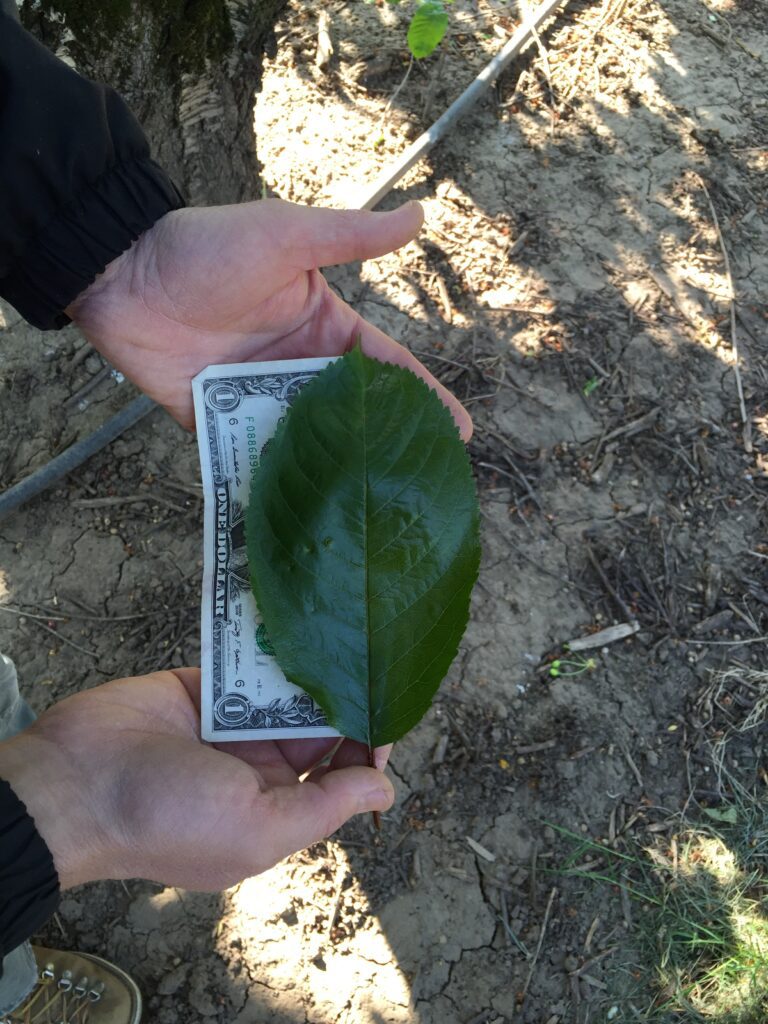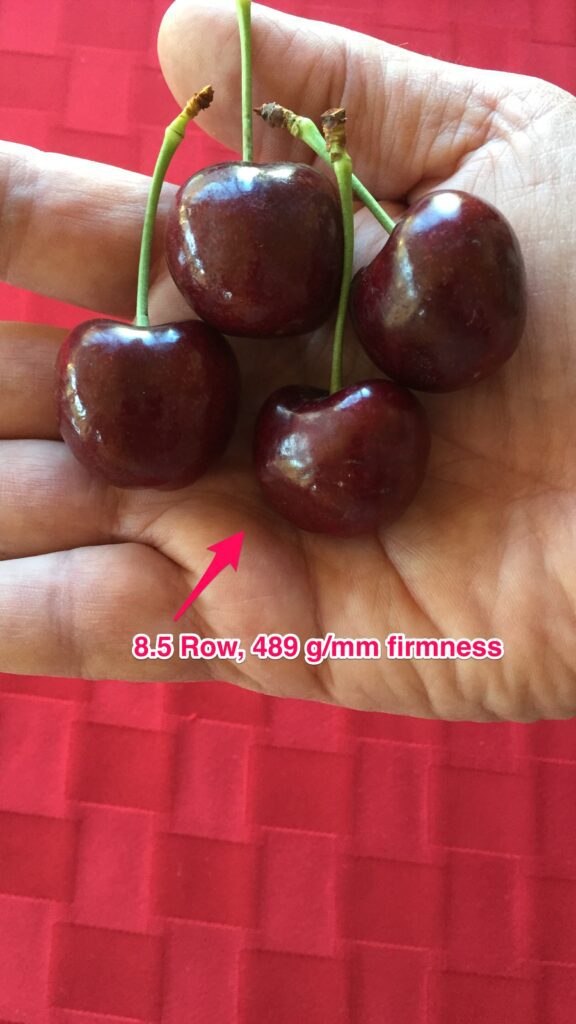Optimal nutrition produces better results than intentionally induced stress
Is it possible to stress a crop at just the right time to make it produce a higher-quality fruit or essential oil? Some growers feel the need to stress a crop to get a sweeter wine, strawberry or blueberry. In cannabis or hemp, growers often stress a crop to get a higher potency.
Can a crop reach its true genetic potential by stressing it? What does this cost in the end? Can we produce an even better result if we work with nature instead of against it?

Increased leaf size = increased energy = increased yield.
Growers sometimes intentionally induce water or nutrient deprivation in their plants, or even severe defoliation of lower leaves, in order to force the plant to produce a higher-quality end product. The theory is that this will either force more production into the final fruit, instead of putting it into the vegetative parts of the plant, or — as is the presumption with cannabis — to induce a stress response to produce more of its natural defense compounds or plant secondary metabolites. These practices are different from normal pruning to stimulate healthy growth — regular pruning is not done during the growing season to intentionally induce stress.
What we are talking about here is epigenetics. For the purposes of this discussion, epigenetics can be described as managing the environmental conditions to encourage plants to reach their true genetic potential in sweetness, flavor, potency and yield.
Take grapes and strawberries, for example. If you withhold water at the right times from these crops, it is said that you will have sweeter, or higher-Brix, fruit. That may be the case, but have you optimized the yield at the same time? The higher Brix is a result of the concentration of the dissolved solids in the plant due to the reduction of the moisture and possibly other nutrients, which in turn will reduce the final weight of the fruit. In the case of strawberries, where there will be more fruiting cycles in the later berries, how much are you reducing the productivity of the later berries? Would it not be better to maintain the optimal water levels and balance the nutrients to allow the plant to produce at its true genetic potential, thereby enhancing quality first?
A plant’s top priority is to produce one high-quality progeny first. If it has enough energy, it will produce another and another, all the way to its true genetic potential. Once the quality is optimized, the plants will naturally produce the best genetic yield possible. If we provide the optimal environment and nutrition from start to finish, plants can produce high quality first, and then a higher yield will follow.
Sugars or potency are the result of complete photosynthesis. The more complex the sugars (longer-chain sugars) and the plant secondary metabolites (PSM), the better the quality of any genetic variety. If you focus on quality first, yield will follow. Many of our practices are yield motivated since we are paid per pound for the volume we produce. This drives the agricultural industry in general toward producing more pounds per unit area of production.
I have seen this demonstrated in an organic strawberry farm I managed in California, a blueberry farm in Oregon that I consulted on, and an indoor cannabis facility in Colorado that I managed. In outdoor, large-scale farming operations, most crops are sold on a per-pound basis. That means the more pounds per acre, the better. This is often driven by increased nitrogen and potassium applications to enhance yield. By doing this, the nitrogen will compete with either phosphorous or calcium uptake (depending on the form of nitrogen), which will then reduce the complexity of the sugars, proteins and PSMs the plant can form, reducing quality. With reduced quality, you have shorter storage and more handling losses postharvest.
Coming from the conventional mindset of corn, soybeans, wheat and hay production that I learned in college (graduating in 1978), and then farming for 31 years, I had to unlearn some of the concepts promoted in the industrial agricultural world. I transitioned out of the GMO soybeans, corn and conventional wheat model to the regenerative — and then organic — system starting in 1998. My biggest fears were how to handle insects and disease in such a system without fungicides, insecticides and any other “cides.”
After nine years of farming regeneratively — at the end of my 31-year farming career — I had no insect or disease issues with any of the various crops I grew during those years. I built up the biology in my soils with the use of intensive grazing and by getting away from all chemicals. The grazing built up the microbial communities in my soil. My highest-yielding soybeans in all 31 years of farming were in food-grade organic soybeans. I switched from field corn to popcorn and had the highest yield in that crop — which I had grown conventionally as well. At the time, I did not know why I was seeing this happening, but I accepted it happily.
I only learned later — as an agronomic consultant covering 10 states and Ontario — why I experienced the success I did on the farm. I had focused on quality first, and the rest fell into place. After I realized this, I was able to apply this principle to cannabis production and then independent consulting with many other crops.
In working with the Cannabis genus of plants, I learned even more, in a shorter timeframe, about how our commodity plants work. Cannabis includes marijuana, hemp and hops, each of which I have worked with extensively for the past several years. In our facility we had 13 rooms. We planted and harvested one or two rooms each week, meaning that each room was turned over 5.2 times per year. So, in two years and three months, I planted and harvested 12 full crop cycles. Imagine collapsing 12 years of lessons growing annual crops into just over two years!

These cherries improved from 9-10 row size
and 350 g/mm firmness
One thing I like about the cannabis crop is that the product you actually sell has the highest level of plant secondary metabolites the plant can produce. The level of PSMs is the true measure of the quality of any crop, but most crops are not sold on this basis, so it is often not assessed. The growers I was managing were pinching the stalks of the plants to induce a stressor to the plant. They were taking all the lower leaves off the plants to allow the plants to focus on putting its energy into the flower, where the essential oil (cannabinoids, THC, CBD, CBN, etc.) is produced … or so the growers said. I argued that the leaves are the solar panels of the plant — the drivers of energy — and they also store nutrients for later use when the plant demand increases in the final stages of growth.
The most confusing thing to me was that they were flushing all the nutrients out of the plants for the last 10 days of the 63-day flowering cycle to enhance the potency and flavor. (I understand this goes on in the wine grape industry as well to enhance the Brix of the grapes.) This did not make sense to me scientifically, so I tried making a few changes. Instead of pulling all the nutrients out of the feeds and just watering the plants, I just removed the nitrogen (that was their claim to reduced flavor) and kept all the other nutrients in the solution. With this change, and balancing the nutrients via plant analysis during all the phases of growth, we were able to increase the potency by 30 percent across 28 varieties of cannabis we were growing. We had a record high potency on one variety that hit 36.9 percent, up from 25 percent when I first arrived. In doing this, our yield also jumped up to double what it was on a dry matter basis. This convinced me that by improving crop quality, yield will follow. Not unimportantly, we also reduced our nutrient budget from $70,000 per month to just $5,500.
I have seen similar responses in various other crops I currently consult on — even large-scale grain operations. If your plants are fed to optimize their true genetic potential, they will produce the highest complexity and largest amount of plant secondary metabolites — which are also the plants’ defense mechanisms against insects, disease and environmental variations.
In blueberries, I have seen Brix readings go from 10 or 12 to up to 23, and increased antioxidants — one of the major health benefits of blueberries. When this occurred, the yield went from 4,500 pounds per acre to 16,000. In potatoes, we saw the average plant go from averaging 10-12 tubers per plant to 21 (with a high of 29!), with greater uniformity of size. Additionally, they were able to store the potatoes for over eight weeks longer than normal. One caution about potatoes, though: starch weighs less than water, so the weight per acre dropped, while the quality was higher — evidenced by the longer storage window.

Balanced nutrition leads to larger, firmer cherries.
By measuring and monitoring plant nutrition, water quality and water quantity, and by modifying irrigation timing, I believe any crop can improve dramatically from what is conventionally practiced today. I find that most crops are fed too much nitrogen, phosphorus and potassium, and not enough calcium or trace elements. I have seen this time and again, working with farmers in chili pepper fields in Arizona and New Mexico, potato fields in Arizona and Minnesota, and blueberry and cherry orchards in Oregon, not to mention in vegetable greenhouses, citrus nurseries, grain fields and forage pastures.
I once heard that farmers grow what they are “sold” to grow. I would add that they grow crops the way they are “sold” to grow them. There is more profit in selling N, P and K than in trace elements, so conventional agricultural salespeople often focus on the big three and neglect the rest.
How do you manage trace elements? Microbes in the soil are the ultimate balancers of all nutrients in the plant — especially the trace elements. If you provide a good home and feed the microbes, they will work on making these elements available to the plants. You may have to inoculate your soil with microbes if you have been under a high-tillage and/or high-chemical-and-fertilizer program. Microbes know more about what the plants’ needs are than any scientist ever will.
Another method I use is to apply trace elements in foliar sprays that are timed with the critical points of influence in the plant growth cycle. I monitor the plant sap analysis where possible, or tissue analysis when sap analysis is not available.
One thing about sap analysis on a crop is that what you learn from monitoring your nutrient uptake on this year’s crop will better prepare you for how much and when to time your adjustments in the next crop cycle. I suggest you test about every two weeks for full-season crops or even more frequently on short-cycle crops like spinach or lettuce. Each cycle will teach you more about nutrient management, method of application, quantity and timing. Each is important. You can also measure the efficacy of each product you apply to be able to find the one that works most economically.
Gary Reding is the owner of Cascades Consulting, LLC, located in Fort Collins, Colorado. He farmed for 31 years in southeast Indiana on a diversified family farm with livestock, grain, seed and forages. In 2009, he branched out into consulting across North America, working with farms and ranches in the US, Mexico and Canada, with a focus on operations transitioning out of conventional practices.













